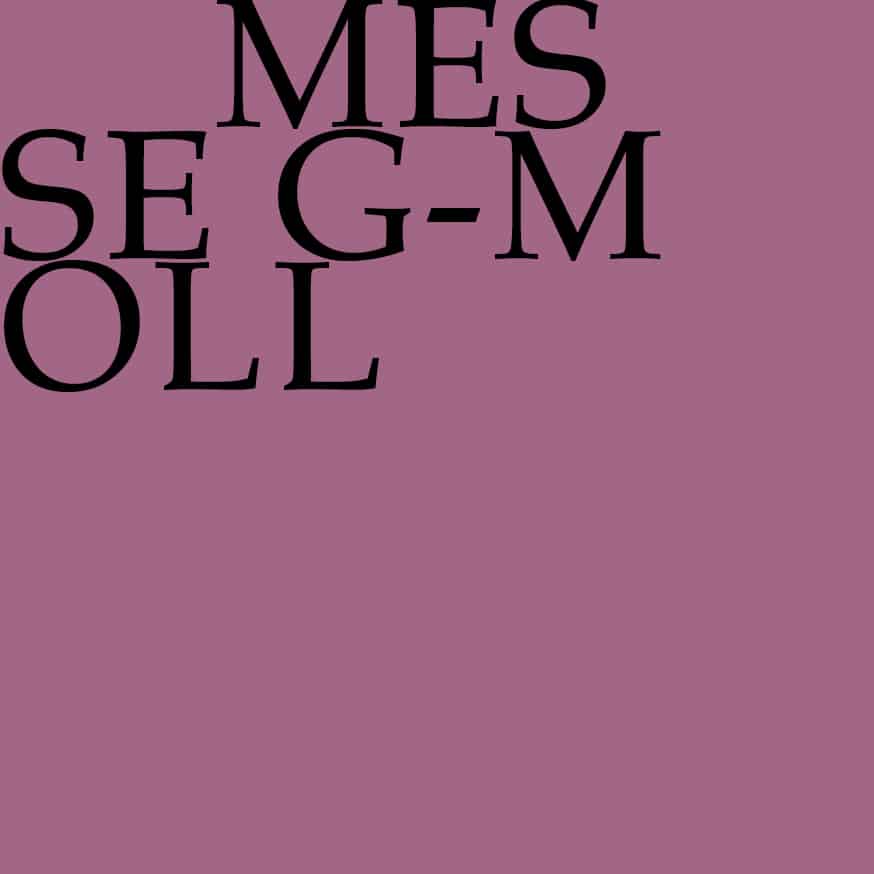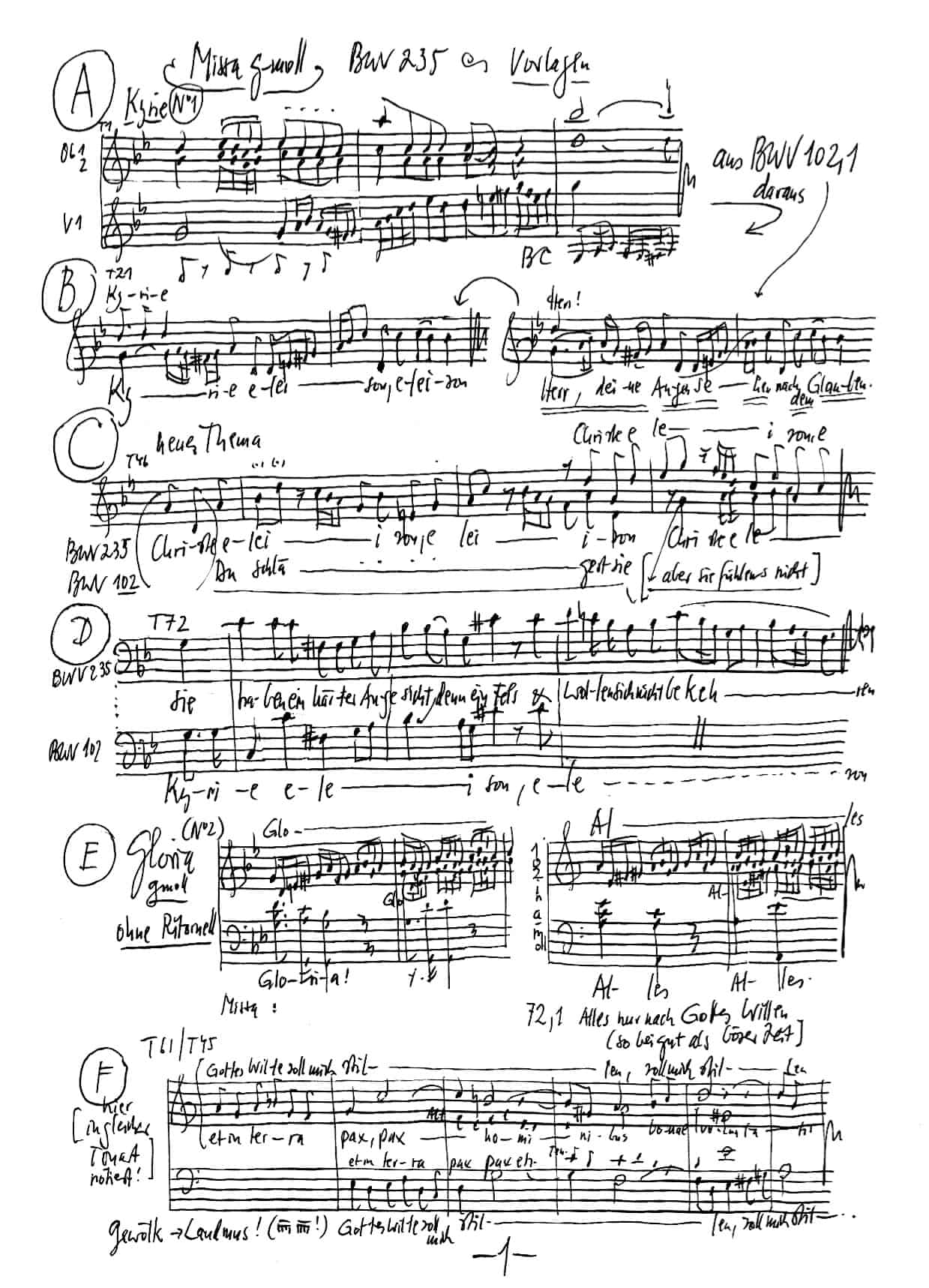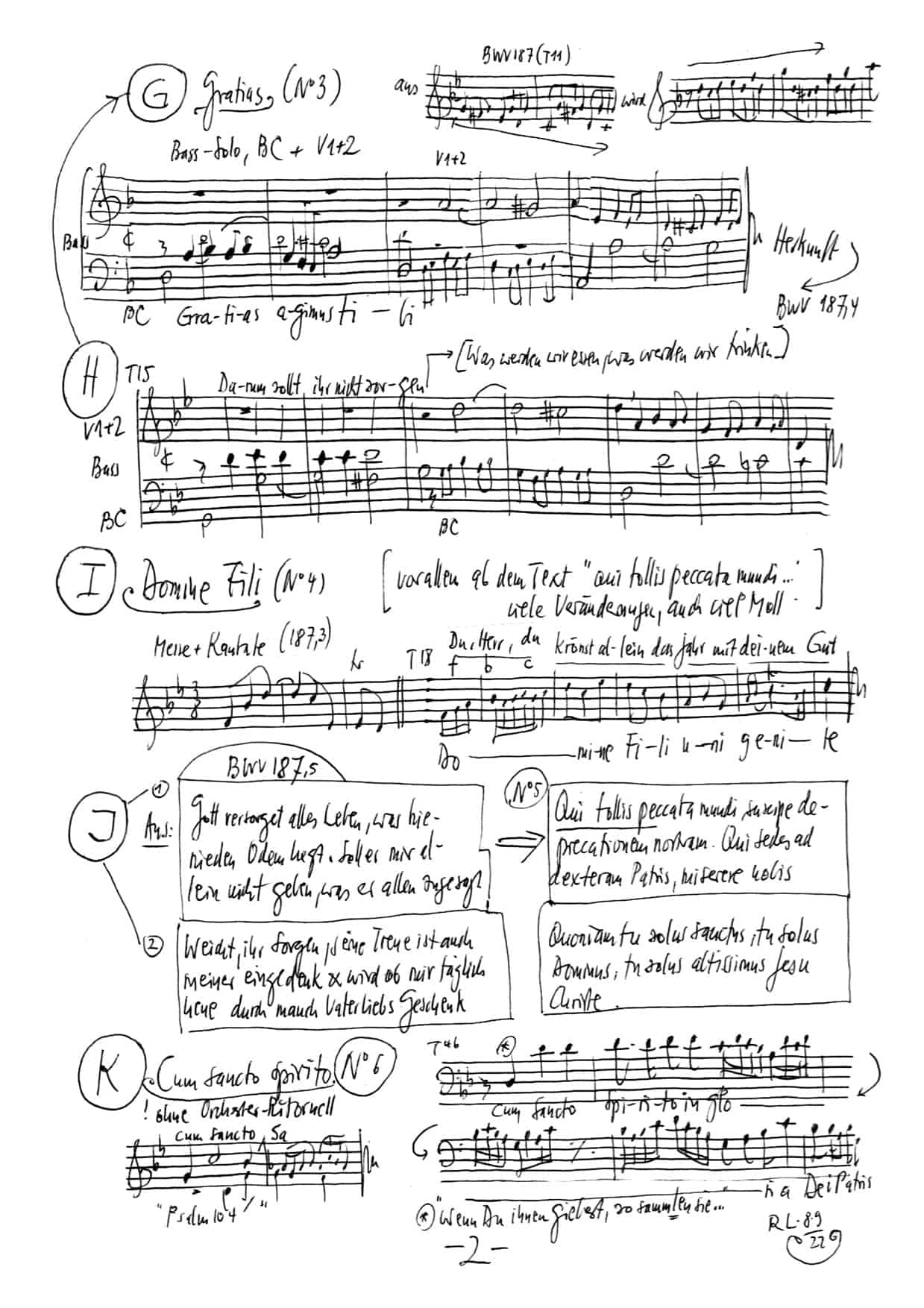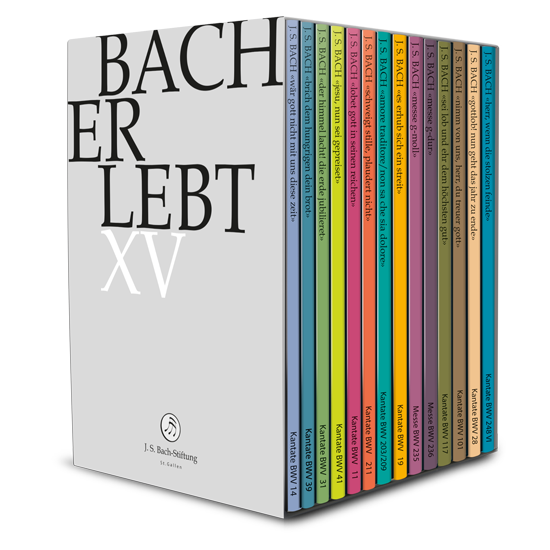Messe g-Moll
BWV 235 //
(Mass in G Minor) for alto, tenor and bass, vocal ensemble, oboe, strings and basso continuo

Would you like to enjoy our videos ad-free? Subscribe to YouTube Premium now...
Workshop
Reflective lecture
Choir
Soprano
Lia Andres, Maria Deger, Noëmi Sohn Nad, Noëmi Tran-Rediger, Alexa Vogel, Ulla Westvik
Alto
Laura Binggeli, Antonia Frey, Stefan Kahle, Lea Pfister-Scherer, Lisa Weiss
Tenor
Manuel Gerber, Klemens Mölkner, Christian Rathgeber, Sören Richter
Bass
Daniel Pérez, Philippe Rayot, Julian Redlin, Peter Strömberg, Tobias Wicky
Orchestra
Conductor
Rudolf Lutz
Violin
Eva Borhi, Lenka Torgersen, Peter Barczi, Christine Baumann, Petra Melicharek, Dorothee Mühleisen, Ildikó Sajgó, Judith von der Goltz, Cecilie Valtrova
Viola
Sonoko Asabuki, Matthias Jäggi, Rafael Roth
Violoncello
Maya Amrein, Daniel Rosin
Violone
Markus Bernhard
Oboe
Philipp Wagner, Andreas Helm
Bassoon
Gabriele Gombi
Harpsichord
Thomas Leininger
Organ
Nicola Cumer
Musical director & conductor
Rudolf Lutz
Workshop
Participants
Rudolf Lutz, Pfr. Niklaus Peter
Reflective lecture
Speaker
Beat Grögli
Recording & editing
Recording date
15/09/2022
Recording location
St. Gallen (Switzerland) // Cathedral
Sound engineer
Stefan Ritzenthaler
Producer
Meinrad Keel
Executive producer
Johannes Widmer
Production
GALLUS MEDIA AG, Schweiz
Producer
J.S. Bach-Stiftung, St. Gallen, Schweiz
Libretto
Kyrie
1. Chor
Kyrie eleison,
Christe eleison,
Kyrie eleison.
Gloria
2. Chor
Gloria in excelsis Deo
et in terra pax hominibus
bonae voluntatis.
Laudamus te, benedicimus te,
adoramus te, glorificamus te.
3. Arie — Bass
Gratias agimus tibi propter
magnam gloriam tuam.
Domine Deus, Rex coelestis,
Deus Pater omnipotens.
4. Arie — Altus
Domine Fili unigenite Jesu Christe.
Domine Deus, Agnus Dei, Filius Patris,
qui tollis peccata mundi,
miserere nobis.
5. Arie — Tenor
Qui tollis peccata mundi, miserere nobis,
suscipe deprecationem nostram.
Qui sedes ad dexteram Patris,
miserere nobis.
Quoniam tu solus sanctus,
tu solus Dominus, tu solus altissimus
Jesu Christe.
6. Chor
Cum Sancto Spiritu
in gloria Dei Patris, amen.
Reflection by Cathedral Pastor Beat Grögli
on the occasion of the performance of the “Luther Mass” in G minor by J. S. Bach on
15 September 2022 in the Cathedral of St. Gallen
Ladies and Gentlemen
It is something special when the Bach Foundation performs a so-called “Luther Mass” by Johann Sebastian Bach in the Catholic cathedral and invites the Catholic cathedral pastor to give a reflection. I was very happy to accept this invitation to speak to you in this beautiful setting, in this place where I have been allowed to help shape the church for 9½ years, in this church that has a wide roof and is polyphonic – not only tonight, but again and again.
For me, it is natural to think about the mass after when performing a “Luther Mass”. I would like to share these thoughts with you, moving back and forth between the musical work and the Catholic Mass. I will unfold my thoughts along three Latin keywords that have become important to me in my own spiritual life.
The first keyword: repetitio iuvat – repetition helps. It is madness to think that everything in life must always be new and unique. Such a life does not exist, and it would also be quite overwhelming for all of us. We are glad that things repeat themselves – especially the beautiful and helpful ones. In the introduction to the work we have already heard that Johann Sebastian Bach cleverly drew on earlier cantatas for his Kyrie Gloria Masses. So the melody repeats itself. What was once good should not disappear after a single use, but be used again: Recycling and transformation. Bach did this extraordinarily skillfully, not simply repeating something at crucial points, but reformulating it for a new place, for a new time. Nevertheless, the following is true: Repetitio iuvat. Repetition helps: in life, in everyday life, in learning, in practicing.
Repetition definitely helps in the religious sphere as well. Catholic worship is – by and large – a repetition. That is in the very nature of things when Jesus says: “Do this in remembrance of me! ” Here something is repeated that Jesus did. The words and signs of the Catholic Mass follow an order that repeats itself. In liturgical terminology, this is called the “ordinarium”, that which comes every time. The proprium is then those texts that are specifically set for that day: from Sunday, from the feast day, on the saints’ memorial days. I can’t tell you how glad I am that the Catholic Order of Mass exists! It would be a total overload to reinvent the service every time. The repetition helps me to simply give myself into this order. It is not first of all a question of putting myself in the limelight, of saying or doing something original, but of allowing myself to be carried along in this common celebration. It would be quite impossible to celebrate two or more services here in the cathedral every day if we had to invent them from scratch. The repetition helps.
It helps to deepen the essential things, because we hear and experience this essential, one thing anew again and again – of course in a new context, in the situation in which we now stand, against the background of new questions; and of course also connected with new elements and new thoughts. I am not talking about a frozen liturgy, but a liturgy that has a meaningful order. Repetitio iuvat – repetition helps.
This already leads me to the second keyword: non multa, sed multum – not the many, but the one, important, essential.
I’ll start with the music: Here in the cathedral, I enjoy many orchestral masses. The libretto is always the same: Kyrie – Gloria – Credo – Sanctus – Benedictus – Agnus Dei. So there is really not much variety in the words. But what great composers have made of it! In 1000 variations: Kyrie eleison – quoniam tu solus sanctus – et incarnatus est – et crucifixus est – et resurrexit tertia dia – benedictus qui venit in nomine Domini. A variety without end, but always based on the one text, the Latin Ordinary. Please: I am not saying that church music should be exhausted in Mass settings. But I want to say that great creativity does not take place where everything always remains open and possible, but in limitation. In life, we do not usually have to look for this limitation ourselves. Life itself gives it to us: In this time, with these forces, with this origin and history, we live our life and give it a shape. Most of the time, we don’t like these limitations. We would rather not have them. They are limiting. But they also give our lives the seriousness and weight that only a human life can have.
I am not a great Bach connoisseur, but the solo cantata “Jauchzet Gott in allen Landen” opened up to me in this way: Bach rises to a musical peak performance because a cantata is needed, but the choir and the orchestra are for the most part lying ill. Bach succeeds in this wonderful jubilant cantata by limiting it to solo soprano and trumpet. So: non multa, sed multum – not the many, but the one, important, essential.
In the Rule of Life of a new monastic community, the communauté de Jérusalemme, I found this spiritual principle again in a beautiful way. The rule classically goes along the three evangelical counsels, poverty, obedience and celibacy, and then simply says: “Have the courage to make your song out of this. “Yes, the evangelical counsels are a constraint. Every life decision, every decision for a way of life is a restriction. But: “Have the courage to make your song out of it. “
I come to my third and last keyword: mysterium fidei – mystery of faith.
In the Catholic celebration of the Mass, this acclamation comes after the so-called institution report. We hear the words of Jesus at the Last Supper: “This is my body” – “This is my blood” – for you. And then: “Mystery of faith – mysterium fidei”. Your death, O Lord, we proclaim, and your resurrection we praise, until you come in glory . So in the middle of the Catholic celebration of the Mass it says: This is a mystery – a mysterion. In the sense of: You are never finished with it; you will never be finished with it; it is a journey. The “mystery of faith” is not Catholic or Protestant or Orthodox. It is, thank God, deeper. Jesus, in his life to death on the cross, did and gave everything, God’s love to the last, to the last, and so made all who believe righteous. That is the Protestant Good Friday. And God has spoken his final, glorious yes in the raising of Jesus; Jesus Christ is the yes to all that God has promised. This is the Catholic Easter Sunday. – In the “mystery of faith”, both belong together.
“Mystery of faith”: Music has so much to say about this. Where words reach their limit, where not only the mind but the heart and the whole person are to be addressed, it is not possible without music. It is a religious experience when I find my own melody and can sing it. It is lived faith when a song – I say, for example, “Wer nur den lieben Gott lässt walten” – when this song accompanies and carries me through very different phases and times of life. It is a strong testimony when we praise and thank God in song in all questions and in spite of everything. Music makes the mystery of faith resonate and resound. “Music brings us,” says Olivier Messiaen, “to God in the absence of truth, until the day when he himself will enlighten us with an excess of truth. ” – “Mysterium fidei. “
Ladies and Gentlemen
We listen once again to the Kyrie Gloria Mass in G minor by Johann Sebastian Bach. Repetitio iuvat – repetition helps, after all.
You chose this Bach Foundation performance in the many you could have done this evening. You didn’t jump from one thing to the next, but took your time. Non multa, sed multum – not a multitude, but something, and something properly. The music and the words in this room took us into the mystery that goes infinitely far beyond us, but in which we do not lose ourselves, but find and find again – in the secret at home.






